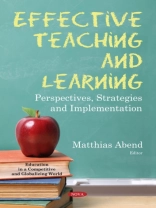Within educational discourse, the idea that teachers should "scaffold" student learning is extremely widespread, yet it is often less clear what this means in the classroom beyond teacher-structured learning activities and the offering of support to students. Effective Teaching and Learning: Perspectives, Strategies and Implementation opens with a review on the use of the term "scaffolding" in teaching, and explains the purpose of scaffolding in the context of Vygotsky’s developmental theory. The authors draw upon Vygotsky’s spatial metaphor for how learning activities could be positioned in relation to the learner’s current and potential levels of development. An analysis of the function of scaffolds, their role in classroom differentiation, and the logic of "fading" is provided. Following this, the authors report one small-scale study that explored an attempt to design materials using principles of scaffolding in an aspect of upper secondary physics known to present learning difficulties to students. The results demonstrate the difficulty of estimating the level at which to pitch learning materials intended to scaffold learning, but also suggest that such materials may contribute to shifting student thinking even when they are not optimally tuned. The results of this small-scale study indicate both the difficulty and the potential of transferring the scaffolding principle from dyadic contexts to formal classroom teaching. Continuing, our nderstanding of learning and the transmission of knowledge has influenced the design of instructional models. Today’s models may appear simplistic, but actually contain very detailed components. Medical education has incorporated instructional designers to assist in developing curricula and to revamp older training programs. Thus, the authors aim to identify the more prominent instructional design (ID) models and their applicability to medical education. With many different instructional design models available, medical educators can be confused and dismayed when first trying to choose an appropriate ID model for educational development. Challenges that medical educators typically overlook, underuse, and overuse when selecting an instructional design model are described. The concluding chapter discusses the need for continuing engineering education and its unique challenges, engineers’ learning preferences (verbal-visual, learning strategy, and multimedia), the importance of prior knowledge, and instructional design strategies for developing more effective training materials for working engineers. This need has been well-documented and is critical for working engineers due to the breadth of processes and equipment they design and use, as well as rapid changes in technology.
Matthias Abend
Effective Teaching and Learning [PDF ebook]
Perspectives, Strategies and Implementation
Effective Teaching and Learning [PDF ebook]
Perspectives, Strategies and Implementation
Köp den här e-boken och få 1 till GRATIS!
Formatera PDF ● Sidor 156 ● ISBN 9781536139440 ● Redaktör Matthias Abend ● Utgivare Nova Science Publishers, Inc. ● Publicerad 2018 ● Nedladdningsbara 3 gånger ● Valuta EUR ● ID 6890247 ● Kopieringsskydd Adobe DRM
Kräver en DRM-kapabel e-läsare












